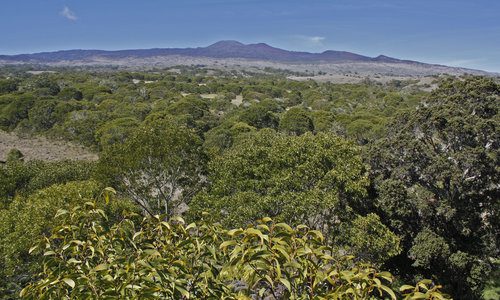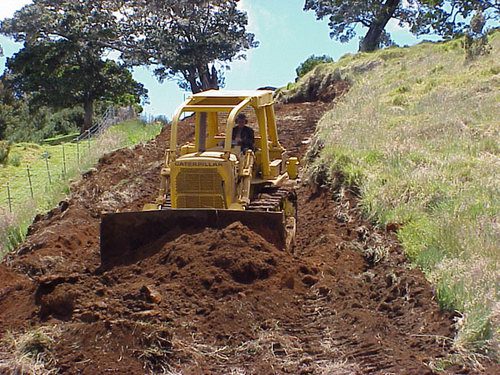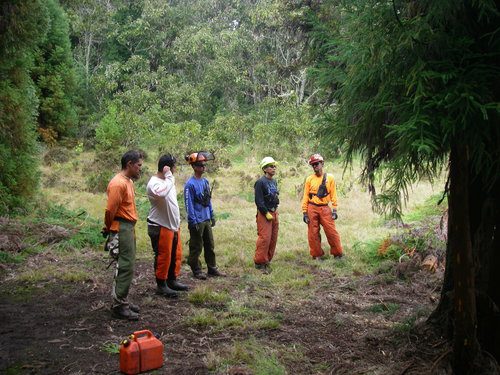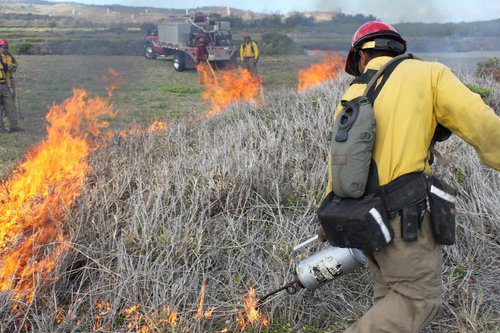In "Partner Perspectives" we get to know the diverse people, roles, and views of wildfire management in the Pacific. When we caught wind that Andy would be retiring at the end of 2018, we seized the opportunity to chat with him before he left his Fire Management Specialist role with US Fish and Wildlife Service.
Name: Andrew (Andy) Kikuta
Role: US Fish and Wildlife Fire Management Specialist (Retired); Pacific Fire Exchange Advisory Panel Member
Pacific Fire Exchange (PFX): What first sparked your interest in wildfire?
Andy (AK): That’d be my first experiences at Hawaii Volcanoes National Park in the 1980’s. I worked as a technician and they were looking for collateral duty firefighters. My supervisor let staff take the training and made us available for Park fires. In the mid- to late- 80s there were many fires in the National Park, so I got a lot of experience.
Helping to suppress fires where they shouldn’t be was hard work, but very satisfying. That stayed with me through the years.
When I got a permanent position with the Fish and Wildlife Service I was still collateral duty, but we had a prescribed fire program to help control gorse. Six years ago I got a full-time fire position, so it’s been a really nice progression and I still have that passion for fire management.
PFX: What were you doing before you were a full-time fire manager?
AK: When I first signed on as a permanent FWS employee, I was hired as a Maintenance Supervisor for Hakalau Forest National Wildlife Refuge. The position title is a little bit of a misnomer because my duties centered around habitat management. I hired a small crew of field people and we’d do everything to help the land recover, restore the land to as close to original as possible. We’d do a lot of fence work, weed control, and pig control. And then of course there were incidental duties surrounding the refuge’s cabins, and other facilities and the fleet.
PFX: What is your day-to-day work like now?
AK: My fire position now is a zone-type of assignment, and I have responsibilities for the entire state of Hawaii and including the Pacific islands from Midway to Guam.


My day-to-day fire activities usually involve planning and coordination. For example, I make sure that all the refuges and monuments in the zone are protected by some sort of agreement. USFWS has a few collateral duty firefighters but not the numbers that we’d need to manage a fire on a refuge if we had one. We would always have the need to call upon others for help.
When I took the position, we might have had only one cooperative agreement -with the Hawaii County Fire Department- but it had expired. So at least I had a template to work with when initiating current agreements with all the fire departments, and now we have agreements with all the Counties except for Honolulu. We also have agreements in place with DOFAW (Hawaii Division of Forestry and Wildlife), which is a state-wide agreement, and with the Park Service. They are a sister agency within Department of Interior, so we often rely on them for help.
PFX: What helps you, as a federal agency employee, to feel effective throughout changing administrations?
AK: Administration definitely affects how effective we are out in the field. Some administrations put less emphasis on managing fuels across the landscape than others. We’re in a time when our budgets are level and we’re not getting more money to do more work. The same amount of money has less buying power as time goes on.
Making sure that the work gets done as best as it can, and as safely as we can, helps me stay engaged. I also appreciate working with other people who help to get things done.
For example, a couple contractors help me with fuels management on the Big Island and on Maui. I have to be clear in their objectives, and I also try to manage the funding to maximize the work they can do. You have to plan ahead, with at least a six-month window to be ready for the next influx of money. Being kept on my toes also helps prevent complacency.

PFX: What do you think could use more attention as it relates to wildfire?
AK: Though the awareness is getting better, when most people think about Hawaii they don’t think of fire as an issue. If you live here, though, you know that it is. It’s important to me to communicate that. Sharing this with the public in general is important, but I think the emphasis should be placed on the support needed from the regional office, which is in Oregon. Folks in the regional office usually come from a large fire program on based the mainland. That’s what they know, and that’s what they’re good at. Things are a little different in the islands, though, especially with the tropical weather. That’s what they need to hear on a regular basis. They don’t realize, for instance, that Oahu gets 500-600 fire starts a year. That’s an amazing statistic if you think about the size of the island. The same goes for Guam, which is smaller than Molokai and gets a high number of fire starts per year as well. Every time I get a chance, I share the statistic from the Pacific Fire Exchange about how a comparable percentage of land area burns each year in the islands as the western states.

PFX: Fish and Wildlife does prescribed burning at the James Campbell Refuge on Oahu. What’s your take on other opportunities for prescribed burning?
AK: Prescribed burning is done at James Campbell for improving habitat for the water birds. Recently we’ve been clearing and burning debris to create habitat for migratory seabirds like the Laysan Albatross. I do know that the Park Service does some prescribed burning for research every so often.
I think it’s a good tool that can also be used to mitigate the potential of brush fires, especially on the west side of the Big Island. There are many fire starts right off the highway. I don’t know how controlled burns would compare to the mechanical control that they’re doing now, but I do know that fire is pretty effective at removing biomass. It’d be effective in preventing unplanned fires along the highway
PFX: What do you want people to know about fire management in Hawaii and the Pacific?
AK: People should know that fire alters the landscape. If you look at Guam, you can see the habitat is changed from all the fires that people intentionally set. The vegetation that comes back is primarily weeds, like sword grass. Over on Oahu we had a fire on the Oahu Forest National Wildlife Refuge in 2015, and now there’s a lot more broomsedge (Andropogon virginicus), a non-native grass that covers the bare ground exposed by the fire. All of those changes result in a more fire-prone habitat. If we don’t manage the situation now we’re going to get more unwanted fires.
I think people also need to realize that a fire-prone habitat can affect them personally. Until this past August (2018) I hadn’t heard of homes (in Hawaii) being consumed by brush fires. With Hurricane Lane we had fires in Lahaina and Waianae, and both resulted in loss of homes.
PFX: What are some enjoyable memories you have about working for USFWS?
AK: All of the gains in restoring habitat is done collectively, through a team of people. No single person can affect that kind of change. It’s teamwork all the way around. Even in fire, there’s no way you can get a handle on fire by yourself.
Some of the fun experiences for me with fire were during the summer months. I don’t know if it’s proper to say that fires are fun, but they do allow for certain kinds of experiences to take place. It gets your adrenaline up. You get dirty and you smell smoky - things that some people might be averse to, but those who are firefighters would understand what I mean.
I always looked forward to my details with the helitack crews on the mainland. Working with them and working with the helicopters as a tool was challenging. I can honestly say that my leadership skills grew in the last six years from those experiences. Working with the helitack crews is something I’ll always remember.

Firefighting is dangerous and nothing that you can do collectively -whether it’s in the islands or within the nation- will prevent accidents or fatalities. I think embracing that fact might cause the national leadership to rethink how we approach suppression. We firefighters often just do something because it’s our job and we can’t really evaluate all of the hazards and risks, so accidents will happen. It’s the nature of the job. So we’ve got to do something about managing the exposure to risk.
PFX: What are you looking forward to doing in retirement?
AK: I’d still like to be involved in fire management so I’m going to be one of those emergency hire folks for the National Park. Because of that I’ll have to maintain my qualifications for the position that I serve in. Training will continue, refreshers will continue, and I’m hoping it motivates me to stay fit and in condition! I want to do other fun stuff like going fishing and doing things that I put on the side for the last 20 years.
PFX: What’s something most people don’t know about you?
AK: I went to grad school to study aquaculture. I hoped to have a career in that, and I’ve always been enamored with the ocean. After I graduated with the degree, I found out there were no aquaculture jobs in the state. So my first job was at Hawaii Volcanoes National Park as a Biological Technician studying pigs. That started my career rolling. I didn’t prepare myself for this and basically fell into what I love doing today.
